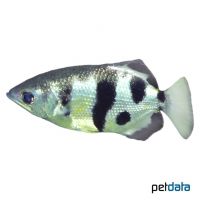Banded Archerfish (Toxotes jaculatrix)
| Banded Archerfish Toxotes jaculatrix | |
|---|---|
| Name | Banded Archerfish |
| Name Lat. | Toxotes jaculatrix |
| Family | Archerfishes |
| Family lat. | Toxotidae |
| Order | Carangarias |
| Order lat. | Carangaria inc. sed. |
| Origin | South and Southeast Asia |
| Habitat | Estuaries, rivers, ponds |
| Diet | Carnivore |
| pH | 7.5-8.0 |
| Behavior | Peaceful |
| Keeping | Group |
| Care Level | Experts only |
| Reproduction | Egg scatterer |
| Breeding | Difficult |
| Life Span | 7-8 years |
| Protection | No |
| Metric Units | |
| Size | 20 cm |
| Temperature | 25-30 °C |
| Hardness | 20-30 °dH |
| Aquarium | ~ 500 l |
| US Units | |
| Size | 8" |
| Temperature | 77-86 °F |
| Hardness | 356-534 ppm |
| Aquarium | ~ 130 gal |
Distribution and habitat
Banded archerfish are widely distributed in nearshore waters from India to the Philippines and south to Indonesia and northern Australia. They live in a variety of biotopes, such as streams, rivers and ponds, as well as in the brackish water of mangrove swamps and estuaries, where they usually stay in shady places with dense, overhanging riparian vegetation.
Maintenance
The aquarium should be structured with some mangrove roots protruding from the water (shelters and hiding places) and aquatic plants as well as provide sufficient swimming space. A dark, round-grained substrate, slightly shaded light, a weak current and green plants near the water surface are ideal. They only need a shallow water depth, about 30 cm is sufficient.
No ammonia, ammonium and nitrite should be detectable, the nitrate value should not exceed 100 mg/l. To ensure the water quality and oxygen content, a filter adapted to the aquarium size and a heater are required, as well as lighting for the species-appropriate day-night rhythm of the animals.
Diet
The food supply consists of terrestrial insects, such as flies, mosquitoes, ants, cockroaches, house crickets or grasshoppers, which are placed e.g. on roots or plants sticking out of the water, as well as cyclops, artemia, daphnia, mosquito larvae etc., which are also well accepted freeze-dried or frozen. After habituation, high-quality, protein-rich dry food (flakes, granules) is also accepted, but should not be the main component of the diet. Only as much should be fed as is eaten within a few minutes. A regular and varied diet promotes health and increases resistance.
Behaviour and compatibility
It is recommended to keep them in a group of 5-8 animals. They can be well socialized with larger, calm fish. Too small fish are considered food.
Basically, only compatible fish species with similar requirements for water conditions and water temperature should be socialized.
Sex dimorphism
There are no known external distinguishing characteristics.
Reproduction and breeding
There are isolated reports of successful breeding in the aquarium.
Important
Banded archerfish live in both brackish and freshwater (amphidromous). Juvenile fish require brackish water (2-4 tablespoons of sea salt to 10 l of water). Commercially available animals are usually already accustomed to freshwater and can be kept permanently in freshwater. Nevertheless, care should be taken when transferring and changing water
They need a lot of warmth and should not be kept below 25 °C.
For acclimation insects, which they can accept from the water surface, should be offered
They owe their name to their ability to shoot insects sitting above the water surface with a targeted water jet. The hit insects fall into the water and can be eaten
Banded archerfish can easily be confused with spotted archerfish (Toxotes chatareus), but they have 5 hard rays in the dorsal fin and the spots in the dorsal fin are distinctly separated from the transverse stripes
The well-being of the fish should be checked regularly. Temperature should be checked daily, pH, hardness and nitrate levels at least every 14 days. Regular partial water changes are recommended, even if the contaminant level has not yet reached the upper limit. Sudden changes in water quality should be avoided. Newly introduced fish must be accustomed slowly to the water in the aquarium.
Further literature can be found in your pet store.
References
Text: Werner Winter; Image: petdata
Source: BMEL (1998): Tierschutzgutachten - Haltung von Zierfischen (Süßwasser); RIEHL & BAENSCH (2004): Aquarien Atlas Bd. 1, Mergus Verlag; ENGELMANN (2005): Zootierhaltung - Tiere in menschlicher Obhut: Fische, Verlag Harri Deutsch
- Gemäß § 21 Abs. 5 Tierschutzgesetz idgF
